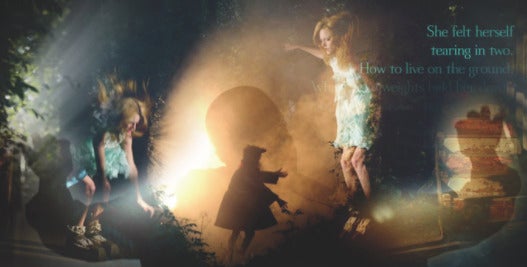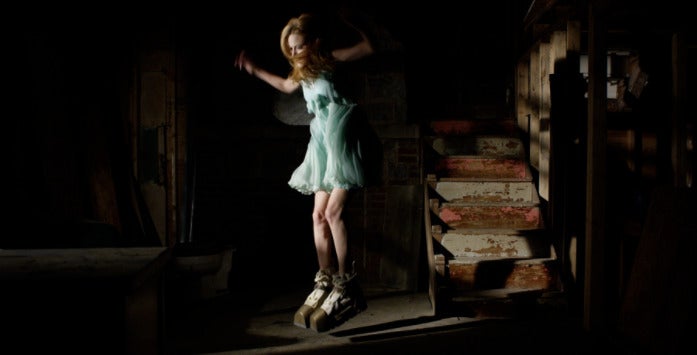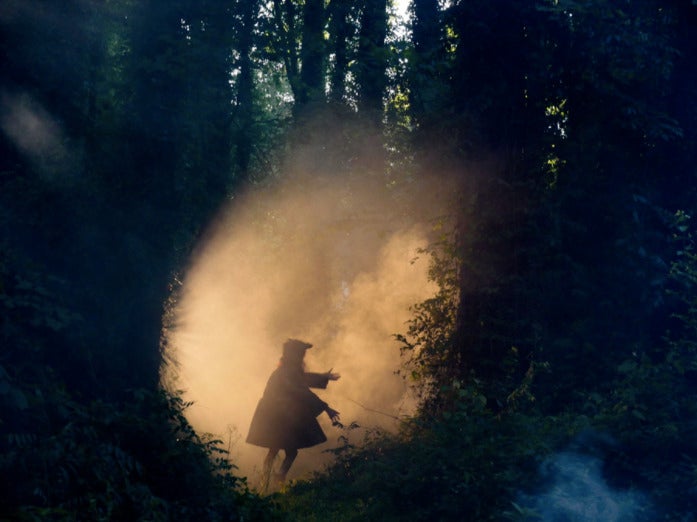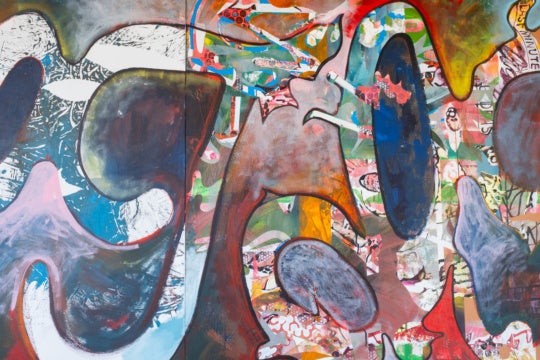
Bill Orisich + Benita Carr’s 4-channel video installation ground.loop consists of three screens of images from the video and lines of poetry projected in the front gallery, and the full video in the back gallery. What it is, beyond that unhelpful description, may well depend on what experiences and assumptions you bring to it, even more so than with most films or videos.
I came to ground. loop. with vivid memories of classic poetic and/or surrealist films including the one of which it most reminds me, Maya Deren’s Meshes of the Afternoon. But this history-focused background omits all the recent videography and filmmaking that is reflected in Orisich’s adroit digital composition. I declare my starting point by way of preface, because it unconsciously influences even my choice of words to describe Carr and Orisich’s artwork, the latest in a process of collaboration that these Atlanta artists have continued since 2002.

The video was created by an elaborate process of intense collaboration with several other creators, starting from poems written by well-known Atlanta poets Dennis Coburn and Debra Hiers. Parts of these poems became voiceovers spoken or sung by Tara Buende, Jamel Morris, and Shana Cohen for performances by Shana Robbins, Marianne, and Tre McClendon in which Robbins plays a would-be dancer weighted down by diver’s shoes, Marianne a mysterious, semi-shamanic forest woman, and McClendon an accomplished tap dancer who, we are told, began by wearing his vanished father’s diver’s shoes in childhood. Robbins’s and McClendon’s ethnicities make for a multilayered symbolic (as well as literal) white/black duality, while Marianne’s appearance as a seeming spirit of nature with, at one point, a branch clenched in her teeth suggests a figure beyond any dualities or categories whatever.
Robbins, weighed down by an irremovable burden that makes “the smallest movements seem like rebellion,” as Coburn’s poem puts it, can only put the shoes to the purpose for which they were intended, descent into a body of water. At this point, we are in a realm of symbolism so traversed by previous films, poems, and works of fiction that it is difficult not to leap ahead to the probable outcome.
This outcome, however, does not come. The beauty of bits of collaboration combined by brilliant editing is that the loosely connected parts are greater than the potentially disappointing whole that is left undelivered. Developed to their expected conclusions, the components would be treading a path of spiritual or artistic initiation that was closed to traffic fifty or so years ago. Instead, they create an atmosphere so visually mesmerizing and full of possible meaning that more than one person has chosen to view ground.loop. several times in succession.

It’s possible to spin several seemingly contradictory allegories out of this material, which is proof of the fact that it isn’t an allegory. The narrative poem that Coburn offers us in lieu of the standard artist statement offers a few clues as to motive: “It begins with an unformulated feeling, / A vague knowing, / That something is wrong, / That could be right, / With a small, shaping shove, / A little to the left. / A herding of elements into position…. It begins as an experiment, / Masquerading as an accident, / Formerly designed to shield you from you, / And ruined now, / By your willingness, / To let it do, what it do, / To let it be, to let it live, / Out in the open, / Despite, / The defeat of expectation.”
The experiment succeeds, despite all the risks of failure, in defeating expectation. How much it succeeds, and how deeply, depends on what you bring to your role as experiencer.
It seems an excellent analogue for our time in which old symbols have been dislodged from their traditional positions and no interpretation of them ever seems quite wrong or quite right, although opposing interpreters have never been more insistent on their own version of what they consider to be self-evident truth. I suspect that ground.loop. has succeeded in its self-declared wish to be “a rock with wings”—a heavy paradox that soars at unanticipated moments and, if we hit the right air currents, carries us with it.
ground.loop is at Whitespace through February 10.
Jerry Cullum is a freelance curator and critic living in Atlanta. His poems, reviews, and essays have appeared in a wide variety of local and national publications, including Art Papers and Art in America.




